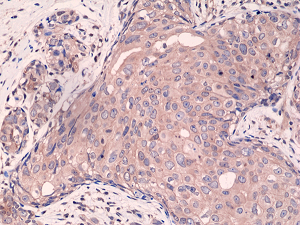anti-SMAD4 (human), mAb (rec.) (PAS7-C7)
AG-27B-6331
ApplicationsELISA, ImmunoCytoChemistry, Other Application
Product group Antibodies
ReactivityHuman
TargetSMAD4
Overview
- SupplierAdipoGen Life Sciences
- Product Nameanti-SMAD4 (human), mAb (rec.) (PAS7-C7)
- Delivery Days Customer10
- ApplicationsELISA, ImmunoCytoChemistry, Other Application
- CertificationResearch Use Only
- ClonalityMonoclonal
- Clone IDPAS7-C7
- Concentration1 mg/ml
- Estimated Purity>95%
- Gene ID4089
- Target nameSMAD4
- Target descriptionSMAD family member 4
- Target synonymsDPC4, JIP, MADH4, MYHRS, mothers against decapentaplegic homolog 4, MAD homolog 4, SMAD, mothers against DPP homolog 4, deleted in pancreatic carcinoma locus 4, deletion target in pancreatic carcinoma 4, mothers against decapentaplegic, Drosophila, homolog of, 4
- HostHuman
- IsotypeIgG1
- Protein IDQ13485
- Protein NameMothers against decapentaplegic homolog 4
- Scientific DescriptionRecombinant Antibody. Recognizes human SMAD4. Applications: ELISA, ICC, PLA. Clone: PAS7-C7. Isotype: Human IgG1. Formulation: Liquid. In PBS. The TGF-beta signaling pathway regulates key cell fate decisions during embryonic development and in adult homeostasis. This pathway is deregulated in many pathological conditions, including cancer, autoimmunity and fibrotic diseases. TGF-beta functions as a tumor suppressor in early tumors, inhibiting progression through the cell cycle. TGF-beta binds a heterotetrameric cell surface complex composed of type I and II serine/threonine kinase TGF-beta receptors (TGFBRI and TGFBRII). Ligand binding causes receptor phosphorylation and transmission of the signal to a class of intracellular intermediates, the receptor-regulated SMAD proteins. The SMAD family is divided into three subclasses: receptor regulated SMADs, (SMADs 1, 2, 3, 5 and 8); the common partner, (SMAD4) that functions via its interaction to the various SMADs; and the inhibitory SMADs, (SMADs 6 and 7). TGF-beta signaling pathways engage two specific receptor-regulated SMAD proteins, the SMAD2 and SMAD3. The C-terminal MH2 domains of the receptor-regulated SMADs are phosphorylated by the intracellular kinase domain of TGF-beta receptors. The receptor-regulated SMADs then interact with SMAD4 and translocate to the nucleus, where they act as transcriptional regulators. Although TGF-beta signaling engages the above three SMAD proteins, SMAD2, SMAD3 and SMAD4, there is a dominant role of SMAD3 as a mediator of both physiological, homeostatic signaling and of pathophysiological perturbed signaling in all diseases. The SMAD proteins are central nodes in the mechanisms of cross-talk between the TGF-beta pathway and other signaling pathways, including the Notch and Wnt signaling pathways. The SMAD proteins regulate multiple cellular processes, such as cell proliferation, apoptosis and differentiation. SMAD7, also known as Mothers Against Decapentaplegic homolog 7 (MADH7), inhibits selected pathways by binding directly to cell-surface receptors and preventing the activation-induced phosphorylation of other SMAD subunits. - The TGF-beta signaling pathway regulates key cell fate decisions during embryonic development and in adult homeostasis. This pathway is deregulated in many pathological conditions, including cancer, autoimmunity and fibrotic diseases. TGF-beta functions as a tumor suppressor in early tumors, inhibiting progression through the cell cycle. TGF-beta binds a heterotetrameric cell surface complex composed of type I and II serine/threonine kinase TGF-beta receptors (TGFBRI and TGFBRII). Ligand binding causes receptor phosphorylation and transmission of the signal to a class of intracellular intermediates, the receptor-regulated SMAD proteins. The SMAD family is divided into three subclasses: receptor regulated SMADs, (SMADs 1, 2, 3, 5 and 8); the common partner, (SMAD4) that functions via its interaction to the various SMADs; and the inhibitory SMADs, (SMADs 6 and 7). TGF-beta signaling pathways engage two specific receptor-regulated SMAD proteins, the SMAD2 and SMAD3. The C-terminal MH2 domains of the receptor-regulated SMADs are phosphorylated by the intracellular kinase domain of TGF-beta receptors. The receptor-regulated SMADs then interact with SMAD4 and translocate to the nucleus, where they act as transcriptional regulators. Although TGF-beta signaling engages the above three SMAD proteins, SMAD2, SMAD3 and SMAD4, there is a dominant role of SMAD3 as a mediator of both physiological, homeostatic signaling and of pathophysiological perturbed signaling in all diseases. The SMAD proteins are central nodes in the mechanisms of cross-talk between the TGF-beta pathway and other signaling pathways, including the Notch and Wnt signaling pathways. The SMAD proteins regulate multiple cellular processes, such as cell proliferation, apoptosis and differentiation. SMAD7, also known as Mothers Against Decapentaplegic homolog 7 (MADH7), inhibits selected pathways by binding directly to cell-surface receptors and preventing the activation-induced phosphorylation of other SMAD subunits.
- ReactivityHuman
- Storage Instruction-20°C,2°C to 8°C
- UNSPSC12352203





